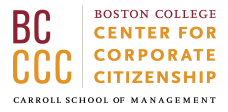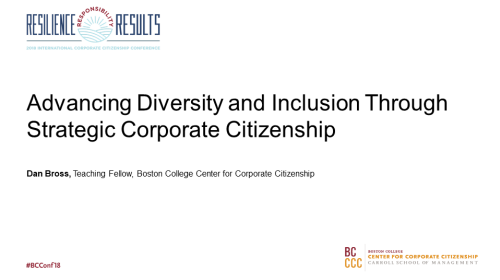 Before Boston College Center for Corporate Citizenship member company, Google, became one of the most successful companies of our time, and before co-founders Larry Page and Sergey Brin joined forces, the two incessantly argued with one another at Stanford. Despite their differences of opinion and background—Brin is from Russia and Page is from Michigan—the two found themselves working together on a paper, “The Anatomy of a Large-Scale Hypertextual Web Search Engine,” the findings of which became the intellectual basis of Google. These unlikely partners found common ground ultimately in their shared passion for data mining.
Before Boston College Center for Corporate Citizenship member company, Google, became one of the most successful companies of our time, and before co-founders Larry Page and Sergey Brin joined forces, the two incessantly argued with one another at Stanford. Despite their differences of opinion and background—Brin is from Russia and Page is from Michigan—the two found themselves working together on a paper, “The Anatomy of a Large-Scale Hypertextual Web Search Engine,” the findings of which became the intellectual basis of Google. These unlikely partners found common ground ultimately in their shared passion for data mining.
Brin and Page were able to do what is necessary for all successful partnerships—they put the work first, drew on the strengths of their partner, and focused on the impact of their efforts. Effective corporate citizenship partnerships must do the same. In many cases, these partnerships connect many different sectors—from government to nonprofits, or even companies in your supply chain or in your industry—that may fundamentally disagree about elements of the solution. The path to successful partnerships lies in finding ways past the differences to address the important global challenges we all face.
In an effective partnership, distinct knowledge and resources exist on both sides. For example, nonprofits and NGOs may have specialized expertise about how to meet the demands of under-served communities. However, many lack the financial means necessary to operationalize their goals. In fact, a 2014 survey by the Nonprofit Finance Fund found that while 76 percent of nonprofits experienced increased service demands, 52 percent could not meet them due to scarce resources. Corporations, on the other hand, often have the resources and business acumen to put programs into action but may need the assets of an active community organization to execute on societal goals. For this reason, intra-industry partnerships are an important component of companies' corporate citizenship strategies.
From purely philanthropic alliances to more complex, fully integrated collaborations, companies engage in a wide array of partnerships in order to address issues material to their operating contexts such as education, healthcare, and the environment. Beyond the impact partnerships have on society, partnerships also have the potential to increase employee engagement, strengthen stakeholder relationships, and provide opportunities for positive brand differentiation.
All partners are not created equal, however. Does the organization track and evaluate its efforts, and can it provide you with meaningful data on inputs, outputs, outcomes, AND social impact—the long-term effects on the overall targets? According to the Center’s 2015 Community Involvement Study, not even 30 percent of companies are currently evaluating this last—most important—factor, possibly because not even 25 percent of them are conducting nonprofit evaluations (see Figure A). Understanding what information your partner is able to provide is vital to determining whether they’ll be a successful long-term partner for achieving your targets.

With strong leadership, a shared vision, and collective accountability, partnerships have the potential to be a “win-win”, with both companies and nonprofits achieving their goals of creating sustainable and high-impact programs to improve conditions in society and maximize business performance.

 Before Boston College Center for Corporate Citizenship member company, Google, became one of the most successful companies of our time, and before co-founders Larry Page and Sergey Brin joined forces, the two incessantly argued with one another at Stanford. Despite their differences of opinion and background—Brin is from Russia and Page is from Michigan—the two found themselves working together on a paper, “The Anatomy of a Large-Scale Hypertextual Web Search Engine,” the findings of which became the intellectual basis of Google. These unlikely partners found common ground ultimately in their shared passion for data mining.
Before Boston College Center for Corporate Citizenship member company, Google, became one of the most successful companies of our time, and before co-founders Larry Page and Sergey Brin joined forces, the two incessantly argued with one another at Stanford. Despite their differences of opinion and background—Brin is from Russia and Page is from Michigan—the two found themselves working together on a paper, “The Anatomy of a Large-Scale Hypertextual Web Search Engine,” the findings of which became the intellectual basis of Google. These unlikely partners found common ground ultimately in their shared passion for data mining. 




